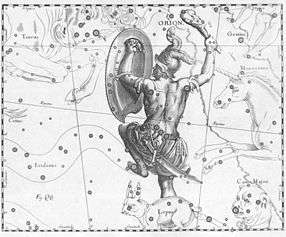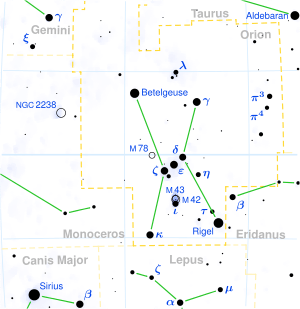Orion's Sword
Orion's Sword is an astronomical asterism in the constellation Orion. It comprises three stars (42 Orionis, Theta Orionis, and Iota Orionis) and M42, the Orion Nebula, which together are thought to resemble a sword or a scabbard. This group is situated under the prominent asterism, Orion's Belt, where it points in a southerly direction. Origins behind Orion's Sword are based in mostly Greco-Roman tradition, though this group of stars is referenced as a weapon in multiple cultural contexts (see below).

Components

Orion Nebula
The Orion Nebula consists of a massive molecular cloud (30 - 40 light years in diameter) within the Milky Way Galaxy, though approximately 1,300 light years from the solar system.[1] This makes the Orion Nebula one of the closest HII regions to Earth, a mass of hydrogen that has been ionized by nearby, hot, young stars.[2] Regions like this are called stellar nurseries, nurturing the birth of multiple young stars such as the Orion Nebula Star Cluster.[1] These stars are a significant feature of the Sword asterism.
Main stars
42 Orionis, also called c Ori, is a B1V magnitude star in the northern half of the Orion nebula.[3] Theta Orionis has a more central position in the nebula, and is actually composed of a multi-star system.[4] Iota Orionis is one of the brightest in the collection, located in the bottom of the Orion nebula. Iota Orionis is a spectroscopic binary system, with a variable magnitude of O9III.[5]
Scientific studies
Given the scientific significance of M42, Orion's Sword is a popular spot for stellar and protostellar studies. Using the Hubble Space Telescope, O'dell et al. focused on identifying previously unseen features of the nebula, such as high-ionization shocks, compact sources, and protoplanetary disks.[6] Some studies have focused on the sword region overall. Gomez & Leda found that less than half of the OB and Hα stars in this region are associated with well-defined stellar clusters.[7] This positional similarity, as well as the high star formation rates and gas pressure in the nearby molecular cloud, confirms the previous notion that old, foreground OB stars triggered star formation in this cloud.[7]
References in history and culture
In his De Astronomia, Hyginus describes the constellation Orion having three faint stars where the sword is depicted.[8] Aratus goes into significant detail about the Orion constellation as well, proclaiming: "Should anyone fail to catch sight of him (Orion) up in the heavens on a clear night, he should not expect to behold anything more splendid when he gazes up at the sky.[9] Cicero[10] and Germanicus,[11] the translators of Aratus's Phaenomena, expressed it as ensis, Latin for "sword". Arabic astronomers also saw this asterism as a sword (saif), calling it Saif al Jabbār, Sword of the Powerful One or Sword of the Giant.[12] Orion is one of the few constellations to have parallel identities in European and Chinese culture, given the name Shen, the hunter and warrior. Chinese astronomers made the sword a sub-constellation within Shen called Fa.[13]
This asterism is not always associated with swords. In the myths of the Namaqua, Orion's sword was the arrow of the husband of the Pleaides, daughters of the sky god, who was represented by the star Aldeberan. When he fired his arrow at three zebras (Orion's belt) and missed, he was too afraid to retrieve the arrow due to its proximity to a fierce lion, represented by Betelgeuse. Therefore, he sits in the cold, suffering from hunger but too ashamed to return home.[14] The Twsana called Orion's word "dintsa le Dikolobe," referring to three dogs which chase the three pigs of Orion's Belt. This serves as an etiological myth for why pigs have their litters in the same season Orion is prominent in the sky.[14] Orion's sword is referenced in the song "Dark Of The Sun" by Tom Petty in his 1991 album "Into The Great Wide Open", in the line "saw you sail across a river underneath Orion's sword..."
Gallery
 The Orion constellation, with Orion's sword distinguished by M42. Note the ambiguity of the actual constellation outline, compared to the diversity of its associated myths. |
 How Orion appears in a clear sky. M42, and thus Orion's sword, is one of the brightest and most prominent features of the constellation. |
|---|
See also
Notes
- 1 2 "Orion Nebula: Where stars are born | EarthSky.org". earthsky.org. Retrieved 2017-05-01.
- ↑ "National Optical Astronomy Observatory: M42, Orion". www.noao.edu. Retrieved 2017-05-01.
- ↑ "42 Ori". SIMBAD. Centre de données astronomiques de Strasbourg. Retrieved 2017-04-29.
- ↑ "tet Ori". SIMBAD. Centre de données astronomiques de Strasbourg. Retrieved 2017-04-29.
- ↑ "iot Ori". SIMBAD. Centre de données astronomiques de Strasbourg. Retrieved 2017-04-29.
- ↑ O'dell, C.R.; Wen, Zheng; Hu, Xihai (1993). "Discovery of new objects in the Orion nebula on HST images - Shocks, compact sources, and protoplanetary disks". Astrophysical Journal. 410 (2): 696–700. Bibcode:1993ApJ...410..696O. doi:10.1086/172786.
- 1 2 Gomez, Mercedes; Lada, Charles (1998). "From Head to Sword: The Clustering Properties of Stars in Orion". The Astronomical Journal. 115 (4): 1524–1535. Bibcode:1998AJ....115.1524G. doi:10.1086/300276.
- ↑ Hard, Robin (2015). Eratosthenes and Hyginus Constellation Myths. Oxford, UK: Oxford World Classics. p. 102. ISBN 978-0-19-871698-3.
- ↑ Hard, Robin (2015). Aratus's Phaenomena. Oxford, UK: Oxford WOrld's Classics. pp. 146–147. ISBN 978-0-19-871698-3.
- ↑ Allen, R. H. (1899). Star-Names and Their Meanings. New York: G. E. Stechert. p. 316.
- ↑ Grotius, H. (1600). Syntagma Arateorum. Leyden.
- ↑ Metlitzki, Dorothee (2005). The Matter of Araby in Medieval England. Yale University Press. p. 79.
- ↑ Ridpath, Ian (1989). Star Tales. James Clarke and Co Ltd. ISBN 0718826957.
- 1 2 "South African star myths". Royal Museums Greenwich | UNESCO World Heritage Site In London. 2015-08-18. Retrieved 2017-04-12.